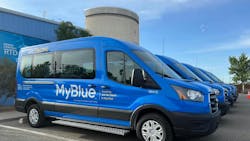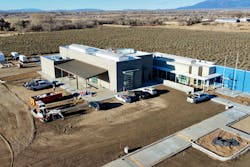The North Central Regional Transit District (NCRTD) is a transit agency that operates in the rural areas of Los Alamos, Rio Arriba, Santa Fe and Taos, N.M. According to the Health Resources & Services Administration, rural areas are defined as “outlying metropolitan counties with no population from an urban area of 50,000 or more people.”
According to NCRTD Executive Director Anthony Mortillaro, being a rural agency has its benefits and challenges.
“We cover over 10,000 square miles for counties, and within there, there's about 70 communities, both incorporated and unincorporated cities, towns, villages and traditionally existing areas that we provide service to, along with eight Indian Pueblo communities and one tribal nation as well; so our community is very diverse, but part of the challenge with that is less frequency and longer routes,” Mortillaro said.
Mortillaro, who will be retiring from the agency in June after serving as executive director of NCRTD since 2011 and has more than 30 years in the transit industry, notes that some of NCRTD’s routes can be 180 miles one way. He says longer routes means there is a higher cost per passenger per mile for the agency.
The agency offers transit options via bus, commuter bus and microtransit. Most of the options the agency provides offer transportation from 6:00 a.m. to 7:00 p.m. Monday through Friday. One of NCRTD’s most-used routes, the 255 Mountain Trail route, provides service through the Santa Fe National Forest area and is fare-free 365 days a year. The MyBlue microtransit option serves the Española, Edgewood, Pojoaque-Nambé and Taos areas and allows riders to schedule their rides up to 30 minutes in advance through either the MyBlue mobile app or over the phone. Fares are $1 per ride, except for paratransit, which is absolved from fares.
To improve services in the area, NCRTD is currently working on three major projects:
- Construction of the Taos maintenance facility.
- Transitioning to a zero-emissions fleet.
- Integrating a rural rapid transit network.
The projects are all part of the agency’s Long-Range Strategic Plan, which was released in 2023 and was created to identify the direction of the organization during the next two decades.
Taos Maintenance Facility
NCRTD broke ground on the Taos Maintenance Facility in 2023. The facility will sit on a six acre site and will feature 7,200 square feet of administrative space and 10,800 square feet of maintenance space, including two maintenance bays, a fueling facility and a battery-electric bus (BEB) charging facility.
Mortillaro notes the agency spent five years planning the project before breaking ground in 2023. NCRTD received various sources of funding for the $17 million project, including:
- $6.6 million from the Federal Transit Administration’s bus and bus facility grant.
- $5.9 million in Infrastructure Investment and Jobs Act funds.
The federal funding covered 67 percent of the project. Mortillaro notes the other 33 percent came from NCRTD as a local match.
According to Mortillaro, the agency learned its lessons from its first facility project, the Española Maintenance Facility. He explains the biggest challenge on the Taos facility was finding contractors to do the work. NCRTD ended up going with Weil Construction for the project, who also did the Española project.
“The two main bidders that bid [on the project] were from the Albuquerque area. That's over 120 miles away, and then there were no local subs that bid the project. All the contractors and subs had to come from the Albuquerque area, so as a result of that, that amplified the cost for the project,” Mortillaro noted.
Mortillaro explains the project scope did not change due to the contracting issue.
“We had sufficient funds to offset the additional cost for the project due to not having any local contractors,” Mortillaro said.
The agency expects to open the facility in spring 2025.
Transitioning to zero emissions
NCRTD launched its plans to transition its fleet to zero-emissions in June 2023. The agency hopes by 2027 to have 25 low- or no-emission vehicles, including:
- 10 electric vans (currently in service)
- Nine hybrid diesel buses
- Six all-electric buses
The agency has three separate contracts with bus manufacturers for the zero-emission vehicles:
- Electric vans - Ford
- Hybrid diesel vans - New Flyer of America
- BEBs - GILLIG
According to Mortillaro, the process of selecting which buses and vans would fit which route was a detailed one.
“What we did with the battery electric [vehicles] is we used CTE, our project consultant on this project, and we had them model the routes that we’re gonna put the battery-electric buses on. So, they modeled three of the routes in Taos and three in Española,” Mortillaro said.
Mortillaro says BEBs were a better option for the agency than hydrogen fuel-cell electric buses due to the lack of hydrogen fuel infrastructure.
“There isn’t any [hydrogen fuel infrastructure] in Española or Taos or New Mexico, so it would either need to be trucked in from an adjoining state, or we would need to build a hydrogen generation plant. Either option was too expensive,” Mortillaro noted.
He adds GILLIG had the longest lasting battery for the routes that the buses will be traveling on compared to other BEB brands. The routes have also been predetermined to eliminate the need to charge the buses during service hours.
“The GILLIG buses have a 648-kilowatt battery, and that one, based on our route design and everything, we would not have to do any mid-route charging. We can just overnight charge and then we'd have enough battery capacity at the end of the routes to still have some battery capacity left over,” Mortillaro noted.
The vehicle procurements did not impact the design of the Taos Maintenance Facility, where the agency plans to charge the buses overnight.
Rural rapid transit network
The rural rapid transit network is the consolidation of the existing fixed routes that operate along the corridor between Taos, Española and Santa Fe into one rapid route. According to NCRTD Planning and Projects Manager Bryce Gibson, some local routes will remain, and areas that are no longer served by the fixed route will instead be served by microtransit. The service will also allow for expanded hours in the future, including an increase in on-demand rideshare services to provide intermodal connections between NCRTD’s fixed-route services and the on demand-services.
Beginning in Taos, the route will be approximately 70 miles each way, as it will travel along NM-68 to Espanola and then take US-285 to Santa Fe. Gibson notes the northern portion of the route travels through a canyon and some frontier lands and adds that the NM-68 route is quite hilly and rugged.
NCRTD’s rural rapid transit network is similar to a bus rapid transit system but has some key differences according to Gibson, who notes the rural rapid transit network doesn't have any separate right of way.
The project is currently in the implementation plan and will be completed in phases, with the first phase consisting of the construction of seven mobility hubs, as well as seven hybrid-diesel buses. Phase one will be funded by a $9.5 million U.S. Department of Transportation Rebuilding American Infrastructure with Sustainability and Equality grant to allow the agency to purchase seven of the nine hybrid diesel buses. Gibson notes the plan calls for a total of 21 zero-emission vehicles along the route, but due to the nature of the route, including the longer distance, the agency believes hybrid diesel buses is currently the best option.
“There are a lot of moving parts to this, but hopefully within the next two or three years we'll be able to start seeing an increase in service related to this project,” Gibson said.
Gibson notes the mobility hubs will be strategically located along the route. Some hubs will be as simple as a bus stop with a shelter while others will have more amenities and look more like a transit station. The agency is currently in the process of planning the locations of the hubs.
According to Gibson, NCRTD plans to implement rider feedback into the rural rapid transit network via open houses and surveys.
Community Transit System of the Year Award
In 2024, the agency not only celebrated its 20-year anniversary, but it won the Community Transit System of the Year Award – Small System, which was presented by the Community Transit Association of America. The award goes to transit agencies who serve rural communities with 50,000 or less people.
Gibson says the award signifies the unity NCRTD employees have.
“I'm really proud of the work that we have been able to accomplish here in NCRTD. We're on the forefront of transit for the regional community. We're a leader, and we are working really hard to develop our facilities and resources in a way that we can benefit our passengers greatly in the future,” Gibson said.
Mortillaro echoed Gibson’s sentiments.
“The district has grown immensely over that time period in both service levels and assets,” Mortillaro said.

Brandon Lewis | Associate Editor
Brandon Lewis is a recent graduate of Kent State University with a bachelor’s degree in journalism. Lewis is a former freelance editorial assistant at Vehicle Service Pros in Endeavor Business Media’s Vehicle Repair Group. Lewis brings his knowledge of web managing, copyediting and SEO practices to Mass Transit Magazine as an associate editor. He is also a co-host of the Infrastructure Technology Podcast.








